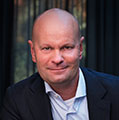- Para particulares
- Para negocios y administraciones públicas
- Para negocios globales
Blog
· 22 Apr 2021
Your digital transformation journey has no final destination
Our second Leading lights boardroom featured insights from digital customer services expert Pramod Madala, Global Head of Enterprise Technology at Diebold Nixdorf.

Por Joris van Oers
Managing Director Global, Business
As part of our Leading lights boardroom programme, we invited Pramod Madala to share his recent experiences in improving customer relations at leading banking and retail technology firm, Diebold Nixdorf.
Madala is a payments industry veteran with multiple stripes on his sleeve when it comes to digital transformation, including improving the payment services at US financial services company Fiserv. And during his time as Global Head of Enterprise Technology at Diebold Nixdorf, he has taken their contact centres to the next level.
Voice is still king
In this session, we focused on trends in customer contact in the financial world and asked the key question, what does the customer want? Our CTO, Colin Bannon, kicked off the discussion, commenting that interaction with customers still takes place mainly via the telephone as it's the quickest way to solve problems.
In fact, Bannon noted, 55 percent of customers worldwide would buy more if mobile transactions were considered safer. What’s more, people are not always happy about the ‘ease of transactions’, repeatedly being asked for information and not being recognised quickly enough can annoy customers and lead to abandoned transactions. Businesses should see this as a call to action: integrate your systems or risk being left behind.
It’s clear that the pandemic has not made things any easier for contact centres, as employees often struggled to work from home. There were even prolonged customer service outages at times. Bannon explained that the response has been an accelerated adoption of SaaS and an explosion in applying AI in customer service, as well as other new demands for processing natural language. AI could lead to faster recognition of the customer and their question and would allow the call to be routed to an employee with the right skills.
Focusing on customer needs
Pramod Madala joined in on the discussion and described how Diebold Nixdorf, with approximately 35,000 employees operating in banking, retail, and connected commerce, is undergoing a digital transformation. "Digital transformation is a buzzword," explained Madala. "To me, it's any kind of technology that makes the business more efficient, effective, and productive. At Diebold Nixdorf, this is all about customer service and therefore a better customer experience, using personalisation."
Madala was clear about the strategy his organisation followed - focusing on the issues experienced by the customer, his team looked at how they could better facilitate employees, optimise operations, and improve customer engagement. The next step was to draw up an execution plan. Madala highlighted that coordination is very important in an international organisation: involving competencies, communication, cooperation, and governance.
Keeping pace with rapid change
Customer behaviour is changing faster than organisations can innovate, observed Madala: "There is no longer any tolerance for a poor customer experience. Personalisation is expected." And so, this became the starting point for revamping their business model.
The team mapped out the customer journey, looking at the customers' needs and where they experience issues. They then modified the customer journey through design thinking. To do this, it was essential to make use of the data collected for deploying AI. Madala noted that automating as much as possible was another starting point.
Shifting from multi to omnichannel
Elaborating on the customer experience theme, Madala explained that the environment at Diebold Nixdorf had different channels, silos, and a non-optimal staff deployment. Working from home because of the pandemic had obviously made delivering a high level of service more challenging. It was important to provide a faster service, reduce the number of touch points, and offer personalisation: “a customer should be able to get in touch with us within 30 seconds” said Madala.
He added, "this specifically meant a shift from multi to omnichannel: we now offer the same service via all channels, based on customer journeys, with identical processes, and a higher performance. We have consolidated our data, which means we can extract insights from it, especially for personalisation, and can deploy self-service tools based on AI. This also allows us to organise and support the work of our agents better.”
Cloud-based solutions for remote working
After thorough planning and research, Diebold Nixdorf subsequently adapted their technology in over 30 contact centres. Pramod Madala described the process: "a diversity of tech was used, locally and in silos. We decided to shift to one type of technology, migrate to the cloud and clean up the legacy. Opting for the cloud helped us to support our employees with homeworking. The project involved finding one single vendor who could meet our requirements to provide a reliable bandwidth anywhere in the world." It proved to be a huge operation.
The wider picture
One session participant asked the question, how can you link overall business strategy with this kind of project: "In my organisation we are missing that kind of maturity." According to Madala, there should be a sponsor from the business such as a CEO, CHRO or COO. A steering committee is required. Diebold Nixdorf set one up with corresponding working groups and without this, there would be no alignment. José Gastey, Director Global Manufacturing of BT suggested the following alternative, "challenge your partners and suppliers to help you create a pitch and buy-in."
The next question from our audience was raised immediately: "How do you measure whether your investments are profitable?" Pramod Madala explained how, from a customer perspective, his organisation uses three main KPIs: shortening the time-to-service, reducing the abandonment rate, and increasing the net promoter score. "If we solve a problem in less time, we can work for less or offer a higher quality."
A journey without a destination
To round off our session, Madala reflected on Diebold Nixdorf’s progress: "this is indeed a journey, but one without a final destination. After all, customer expectations keep on changing. So of course, your digital transformation is not finite either."
Pramod Madala’s three key lessons for CX transformation:
- put the customer first, and continue to do so
- provide choices and don't put customers on the spot by offering just one single option
- offer a frictionless experience.
For help in achieving a digital transformation led by your organisation’s needs, please get in touch with your account manager.

